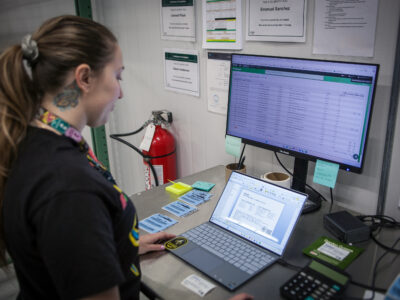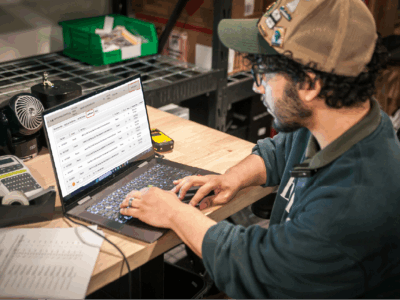The ecosystem of legal medical and recreational cannabis has drastically evolved since 1996 when California became the first state to permit legal access to and use of cannabis for medicinal purposes. In the years to come, legalization would expand across states both medically and recreationally. However, during this infancy phase a key component to public safety wasn’t immediately present – laboratory testing requirements.
Fast forward 25 years and the number of regulated markets with some level of legalization has increased to 41 U.S. states, including the District of Columbia, reaching nearly 268 million U.S. patients and consumers, according to the 2023 MJBizDaily Factbook. While testing requirements are now in place across all legal markets, each state regulates its own industry due to continued federal illegality, meaning testing standards vary market to market.
Navigating the complexities of cannabis testing
Most U.S. states with regulated cannabis have now imposed some form of mandatory safety testing requirements for contaminants like mold, bacteria, fungus, pesticides, and other harmful compounds. Arguably, the most widely discussed topic across the industry is potency – the total amount of cannabinoid content, including tetrahydrocannabinol (THC) or other phytocannabinoids such as cannabidiol (CBD), cannabigerol (CBG), and tetrahydrocannabivarin (THCV).
Today, regulated cannabis must be tested and labeled as certified by state-licensed cannabis testing laboratories, and while several organizations have been attempting to standardize testing methodology, challenges still exist.
Protecting public health with advanced technology solutions
Legal cannabis supply chain visibility is a critical component to enabling the monitoring of potential threats to public safety. That’s why data collected in regulatory solutions providers, like Metrc, which is configured to each state’s unique cannabis testing regulations, allows for quick identification, isolation, and regulatory hold on potentially unsafe plants and products.
In addition, the system is set up to enable efficient product holds and recalls – informing investigations and ensuring all businesses are playing by the same rules – so ultimately, only safe products are available for final sale and consumption. Any products that fail testing can be prevented from being transferred or sold – and must instead be remediated or destroyed.
This approach requires working intimately with state agencies, regulators, and licensed businesses, including testing facilities, to offer:
- Enhanced system functionality that simplifies compliance workflows
- Ongoing industry training and education on testing best practices
- Best-in-class industry support for efficient testing issue resolution
Navigating the complexities of cannabis testing combined with learning the ins and outs of advancing regulatory compliance technology is no small task. That’s why we have compiled a list of best practices when it comes to simplifying cannabis testing as it relates to the Metrc system.
Creating test sample packages in Metrc
Based on product type and state rules, most licensed testing facilities are required, at minimum, to test for potency, contaminants, and pesticides. And while creating test sample packages in Metrc is intended to be straightforward, following these tips prior to submission can help simplify the processing workflow:
- Stay ‘in the know’ on the latest testing regulations.
- Make sure all required information is included.
- Take a few extra moments to verify information for accuracy.
- Understand how Metrc is configured to indicate status – i.e. Final results entered: “Test Passed” vs. “Test Failed”
Finally, when creating retention samples, create as regular packages to avoid locking up product from transfer or further processing.
Reasons for ‘Package Locked for Testing’ status
While common testing issues are avoidable when information is submitted correctly – Source package(s), correct Lab Test Batch, Item Name, Quantity, Destination, and Departure & Arrival times, for example – the good news is many errors can be easily fixed once identified.
Did you know? If enabled by the state and uploaded by the testing facility, licensed businesses can view and download the Certificate of Analysis (COA) to provide test result documentation before accepting a transfer.
Test Sample incorrectly created
Typically, this issue arises when the incorrect Amount, Item Name, or Unit of Measure is entered, an extra test sample is left in inventory, or a test sample is adjusted to zero and finished. To avoid this, verifying information prior to submission is key. If the test sample has been created incorrectly, simply discontinue it and create it correctly.
Pulling from incorrect Source Package or Harvest
To correct this error – and avoid inaccurate weights of testing samples after testing results are returned – the test sample pulled from the incorrect source package or harvest package should be discontinued and remade from the correct source package.
Incorrect Lab Test Batch chosen
When this occurs, it will result in the product being locked as TestinginProgress. However, it can be fixed by using the ‘Change Req’d LTBs’ button to update information to the correct Lab Test Batch prior to transferring.
Extra Test Sample made in error
One of the easiest errors to correct, the extra test sample should always be discontinued rather than adjusting to zero and finishing as this automatically locks up the product unnecessarily.
Repackaging a Test Sample
Like the example above, if a mistake is made when creating a test sample, it should be discontinued and remade correctly. The Metrc system is configured to identify entered test results in the original test sample and, when repacking, no results will be entered.
Testing Facility enters incorrect Lab Test Batch
At times, a licensed testing facility may accidentally create an issue that locks up the product. If this occurs, the testing facility must contact Metrc Support to resolve the issue quickly.
When information is verified and validated prior to a test sample departing the originating licensed facility, taking these few extra seconds saves valuable time and labor in moving compliant, saleable products through the supply chain.
Interested in learning more about testing?
While the Metrc Support team is available to provide guidance and help with more complex situations, on-demand training via Metrc Learn is available 24/7 – including modules for creating a test sample or a retention sample, and a testing specific training tailored to industry roles, facility types, and experience levels – to enable success right out of the gate. For other common corrections that can be easily made in Metrc, visit metrc.com


